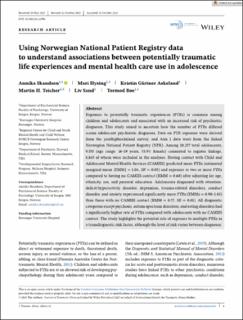Using Norwegian National Patient Registry data to understand associations between potentially traumatic life experiences and mental health care use in adolescence
Skandsen, Annika; Hysing, Mari; Askeland, Kristin Gärtner; Teicher, Martin H.; Sand, Liv; Bøe, Tormod
Journal article, Peer reviewed
Published version

Åpne
Permanent lenke
https://hdl.handle.net/11250/3117583Utgivelsesdato
2023Metadata
Vis full innførselSamlinger
Sammendrag
Exposure to potentially traumatic experiences (PTEs) is common among children and adolescents and associated with an increased risk of psychiatric diagnoses. This study aimed to ascertain how the number of PTEs differed across adolescent psychiatric diagnoses. Data on PTE exposure were derived from the youth@hordaland survey, and Axis 1 data were from the linked Norwegian National Patient Registry (NPR). Among 10,257 total adolescents, 9,555 (age range: 16–19 years, 53.9% female) consented to register linkage, 8,845 of whom were included in the analyses. Having contact with Child and Adolescent Mental Health Services (CAMHS) predicted more PTEs (estimated marginal mean [EMM] = 1.04, SE = 0.05) and exposure to two or more PTEs compared to having no CAMHS contact (EMM = 0.60) after adjusting for age, ethnicity, sex, and parental education. Adolescents diagnosed with attention-deficit/hyperactivity disorder, depression, trauma-related disorders, conduct disorder, and anxiety experienced significantly more PTEs (EMMs = 0.90–1.63) than those with no CAMHS contact (EMM = 0.57, SE = 0.01). All diagnostic categories except psychosis, autism spectrum disorders, and eating disorders had a significantly higher rate of PTEs compared with adolescents with no CAMHS contact. The study highlights the potential role of exposure to multiple PTEs as a transdiagnostic risk factor, although the level of risk varies between diagnoses.
